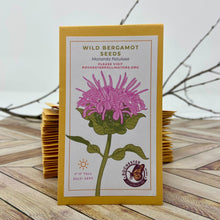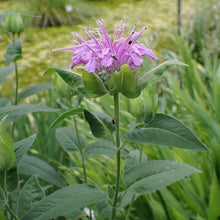Wild Bergamot/Beebalm (Monarda fistulosa)
Native Perennial
Seed Count: ~150 seeds
Days to Germinate: 60 days of cold, moist stratification. See: Winter Sowing & Stratification
Depth to Sow: 1/4"
Seed Spacing: When seedlings are 2" high, thin to 1' apart
Color: lavender, purple
Height: 2' to 4'
Bloom Time: July - September
Sun Exposure: Full sun to part shade
Soil Moisture: Dry to medium soil; does not tolerate wet soil
Soil Type: Clay, dry, shallow & rocky
Attracts: Monarch and other butterflies, hummingbirds, bumblebees, a variety of native bees
Natural Habitat: Moist to dry soil prairies, hill prairies, sandy woodlands, woodland borders, thickets, borders of limestone glades, abandoned pastures and landfills.
Drought Tolerance: High
Deer Resistance: High
Larval Host: Hermit Sphinx moth, Orange Mint moth, and Raspberry Pyrausta moth
Native Zone: AL, AR, AZ, CO, CT, DC, DE, GA, IA, ID, IL, IN, KS, KY, LA, MA, MD, ME, MI, MN, MO, MS, MT, NC, ND, NE, NH, NJ, NM, NY, OH, OK, OR, PA, RI, SC, SD, TN, TX, UT, VA, VT, WI, WV, WY
Pure Live Seed (PLS) Viability Value: 88.9%
Description:
Beebalm or Wild Bergamot has a lovely lavender to purple blossom and distinctively aromatic foliage. It is native to most of North America and a familiar component of prairie and savanna communities on all but the wettest of soils.
Its species name, fistulosa, refers to the tube-like structure of its blossoms, which appear from mid to late summer, nicely complementing nearby yellow composite flowers, like Rudbeckia, Silphium, and Helianthus.
The flowers and leaves of this plant are edible and used for teas and seasoning. Indigenous peoples had many medicinal uses for Beebalm: poultices for boils and lacerations, as well as tea infusions for headaches, indigestion and colds and flu.
Info from www.prairiemoon.com and www.wildflower.org




